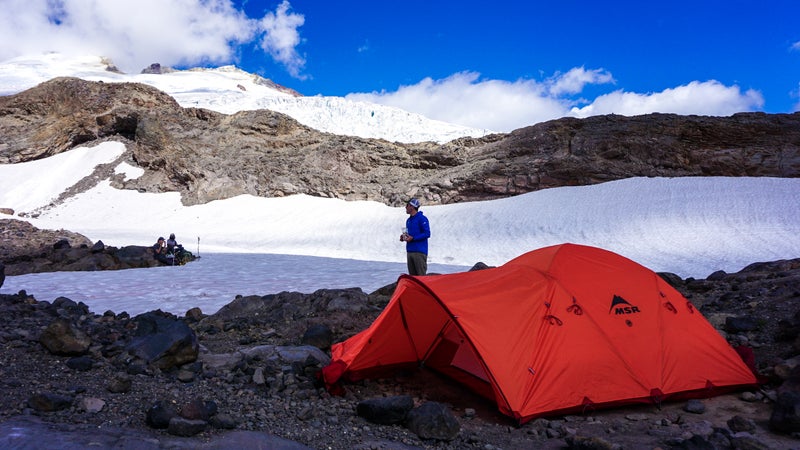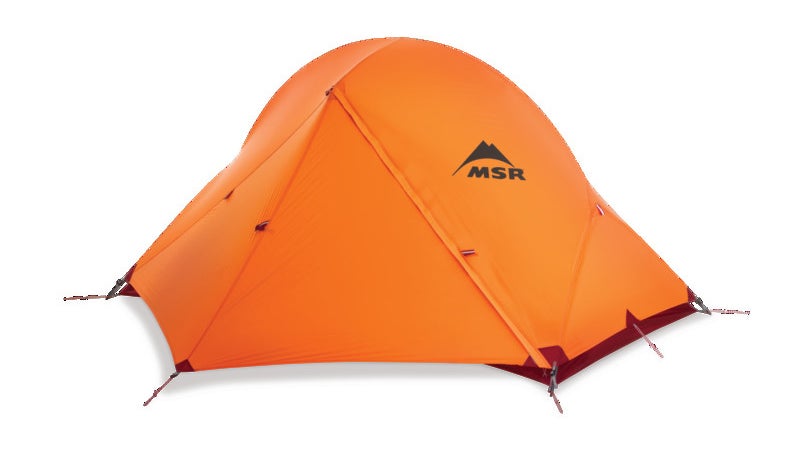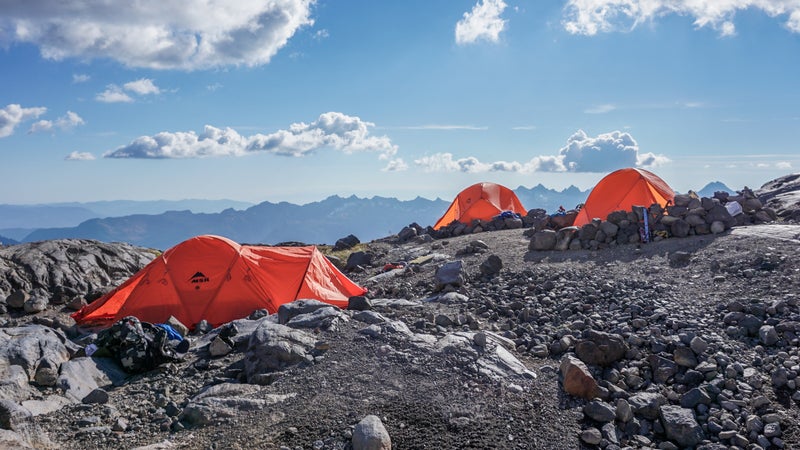Exposed to extreme, extremely variable weather in high-risk terrain, mountaineering gear is critically important—not only to your comfort and performance, but also to outright survival. You’ve also got to carry it up the damn mountain, so it needs to be light, and, if the conditions take a turn for the worse, it needs to comfortably house you for several days at a time.
That’s the challenge MSR’s all-new range of mountaineering tents faces. With the aid of top-flight technology (think Easton carbon fiber poles), they shed weight. They’re aiming to be easier to set up than ever before. And they want to achieve both merits while improving livability—more space for people and gear.
Last week, we used the range to support a summit of Washington’s Mt. Baker. At only 10,781 feet high, it may not sound like the most challenging mountain in the world, but the active volcano is incredibly prominent—rising 8,812 feet from its base. It can also get a lot of snow: in 1999, the ski area on its northeastern slopes recorded 1,140 inches of white fluffy stuff. That contributes to its incredible glaciation—the volume of ice on Baker is only exceeded in the Lower 48 by nearby Mt. Rainier.
Starting at a 3,700-foot trailhead, we packed all our camping and climbing gear up to a high camp, located on a rocky outcrop well above the glacier line, at about 6,800 feet, and camped there for two nights. That first night on the mountain, we experienced very high winds blowing steadily at about 35 miles per hour, and gusting up to 50 miles per hour or more. A standard backpacking tent wouldn’t have stood up to the abuse, and one of MSR’s new tents struggled as well, blowing flat in the gusts, and suffering from broken guy lines. Read on to find out more.

Access
The new Access series (available in 1, 2, and 3P versions) is an odd duck. Designed like a backpacking tent, but built like a mountaineering tent, it aims to fill a winter travel gap that’s not quite mountaineering, but definitely isn’t backpacking. MSR sees its potential users as “skiers, splitboarders, and other touring users,” who primarily camp below tree line.
The good thing about the Access tents is that they’re pretty light: the 1P is just three pounds; the 2P is 3.6 pounds; the 3P is 5.3 pounds. That’s thanks to the same Easton Syclone poles that are propagating throughout MSR’s new tent lines. What makes them heavier than a backpacking tent—and more appropriate for winter duty—are the relatively heavy fabrics used across the body (20D), floor (30D) and fly (20D), with mesh areas limited only to zip windows on the doors. That limited mesh helps them sleep warm, while keeping windblown dust and ash out…if you keep those windows closed. This also limits the tents to cold-weather use. These are not all-season designs, as MSR claims.

The 2P and 3P versions both have two doors, and two generous vestibules for gear storage. They’re spacious inside, comfortably sleeping the designated number of people, while providing adequate height for sitting.
Unfortunately, the backpacking-like design is not up to the task of resisting high-elevation winds. On that first night, the Access struggled to stand up, with the entire frame flattening in some gusts. Guy points on its fly are located too high on the body, allowing the tent to collapse beneath them, while pulling those points down. This problem is exacerbated by a fly that doesn’t reach totally to the ground, allowing wind to enter and turning the tent into a sail. Lines were snapped, little sleep was had: I was genuinely surprised to find the Access still on the mountain at daybreak.
Due to those flaws, I struggle to understand the use case for the Access range. Starting at $500 for the 1P and going up to $700 for the 3P, they’re nearly as expensive as proper mountaineering tents, yet unable to fill that role. Purchasing an expensive tent only for ski touring seems remarkably unnecessary, especially when MSR’s own range of ultralight backpacking tents—we love the —is more than capable of doing double duty below the tree line, at much less weight and cost.

Remote
This is more like it. Sleeping in a Remote 3, we barely knew it was gusting outside, while enjoying an incredibly spacious interior. Two full-size dudes slept in this thing in total luxury; it could have fit four, and their gear, in a pinch.
That’s because the Remote 2 and 3P are designed as proper mountain shelters, capable of withstanding heavy winds and snow, while maximizing livable space. Both have two doors and two vestibules, with the front one providing a spacious porch for ample gear storage, and even bad weather cooking. A to-the-ground fly with snow flaps front and rear totally keeps the wind out of the tent. Like the Access, small mesh panels on the door tops zip open to provide some limited ventilation.
The Remote proved as weather resistant as the Hilleberg Nammatj 3 GT we tested last April, but exceeded that tent in almost every other merit. The MSR has 10 more square feet of interior space, 2.75 inches more interior height, an additional door, stronger carbon poles, and costs $80 less, but does weigh six ounces more. In our opinion, that small weight penalty is made up for by the Remote’s ability to address our biggest criticism of the 3P Hilleberg: where that tent only breaks down into two parts for carry, making it awkward to distribute evenly amongst its inhabitants, the MSR splits into three, roughly equal parts—the body, fly, and poles.

AdvancePro 2
We only used the Advance Pro 2 at base camp, so I can’t weigh in on how well it stands up to wind. Designed to be a minimalist shelter for professional alpinists, its slim dimensions (just 24 square feet of interior floor space, no vestibule) are designed to fit into nooks and crannies mid-climb. It’s also designed so that one person can set it up without moving their feet, just in case space on a ledge really is at that much of a premium.
It’s a traditional single-wall winter tent with very limited ventilation, so it appeared to suffer from a fair amount of condensation down at only 3,700 feet in August, but that use is well outside what it’s intended for. The carbon fiber poles should prove incredibly break-resistant, flexing, rather than snapping under high loads, and contribute to an all-up weight of just 2.9 pounds.
Price is a steep $550, and you’d better really like spooning your climbing partner because the interior is tiny. This tent really is restricted to that single-use case of first ascents and multi-day summits.



